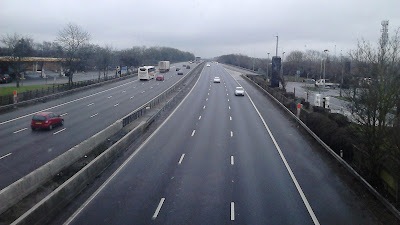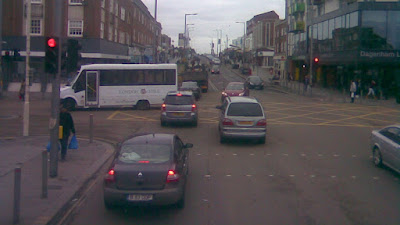People who drive and used to run plumbing companies always seem to have a lot to say about how highway networks should operate and congestion is often something which comes up quite often as their specialist subject.
Of course, anyone who complains about being stuck in traffic will always have a reason why their journey is essential and why everyone else shouldn't be driving.
The Roman engineers who famously forged drainage systems from lead sheet to give us the origin of plumbing, also built a road or two in their time and even back then, traffic congestion was also a problem - to the point where Julius Caesar banned carts from Rome for the first ten hours of each day! Traffic calming was also a thing in Roman times and so it seems that we have been trying to solve the same problems for over 2,000 years.
I wonder if the Roman drive time pundit, Dickus Lamborghini, decried the latest one-way system or the poor hardworking Licenced Sedan Chair Owners' Association complained about congestion at the city gates. Maybe Biggus Jobbus had a particularly nasty blockage in the local baths which took half the morning to get across Rome to clear.
Discourse on how congestion forms, moves and changes is often thought about as an closed system where limiting flow in one places forces flow in another. At the basic level, there are similarities with traffic and water, but they really only apply on motorways and strategic roads where there is no frontage development or kerbside activity and where access is limited - closer to the closed systems of water supply and drainage.
In an ideal hydraulic (a general term covering the science of fluids) system, one can very easily predict and therefore design for a desired flow. For example, temperature, pressure, cross-sectional area of a pipe, "roughness" of a pipe and gradient of a pipe are interrelated things for which we have developed scientific formulae.
We know that in drainage pipes, the maximum flow is just under the pipe being full as we hit a sweet spot just before the roughness of the entire internal circumference affects the capacity. We know that for a given flow, if we reduce the diameter of a pipe, we increase the pressure. We know that where a pipe enters a watercourse, we need to do something to take the energy out of the flow with rip-rap to stop scour of the watercourse bed.
We can apply these principles to the more closed systems like motorways as the traffic flow is predictable, so long as we don't hit capacity limits. For example, on a motorway, we can roughly stuff 2,000 vehicles per lane per hour passed a given point, although with three or more lanes, the outer lanes tend to carry slightly less traffic as speeds (and so distance between each vehicle) are a little higher.
This level of flow is influenced by the proportion of HGVs (which are slower than general traffic), gradients and junctions. The reason motorways have slip roads is so people can join and leave at motorway speed to reduce disruption in the flow as well as being safer. In general terms, this is all fairly easy stuff to predict and design for. The problems comes for motorways and roads like them where the traffic demand starts to exceed the flowing capacity. This is where this type of road can never be a closed system because of spatial planning and other things that influence how and when people travel.
If the rough 2,000 vehicles per lane flows, then it is actually less than the theoretical capacity of each lane. Once flows start to go much higher, then using the pipe analogy, we are moving from just under pipe-full conditions to the pipe-full conditions and so frictional aspects come into play. Someone changes lanes erratically, there's someone driving much more slowly than the general speed or someone tapping their brakes is enough to destabilise the flow and we get a ripple effect of people braking which can even lead to the motorway coming to a standstill very quickly.
This is why motorways operating with variable speed limits and controlled lanes can move higher volumes because an already controlled situation is controlled even more. It seems counter-intuitive, but a managed section of motorway operating with a lower speed limit and better lane discipline can move more vehicles per hour than under the normal motorway speed limit and conditions.
The graph above is quite handy to show what is happening (especially as it doesn't have numbers). The point on the right shows the optimum speed for the maximum flow per lane. Drivers are able to bunch up more closely than at higher speeds, lane changing is being discouraged and although people are moving more slowly than they would at normal motorway speeds, the entire collective of people are all moving efficiently. Once we move past that sweet spot, faster speeds actually means a reduced capacity because we need far longer gaps between each vehicle and lane changing or encountering a much slow vehicle disrupts the system. We have the community advantage of moving as one vs the inefficiency of the individual.
The analogy with water here is laminar vs turbulent flow. At the optimum speed (velocity for the scientists) through a pipe, the molecules in the liquid move forward in straight lines without interrupting their neighbours. Once the speed gets too high, things like pipe roughness starts to knock molecules out of line and they disrupt their neighbours which creates turbulent (or chaotic) conditions which reduces the capacity of the system.
Once you move to an urban situation, things start to change very quickly. Unless we are talking about an urban motorway, we tend to lose junctions which are grade separated and even where we do have it, ramps are often shorter. Traffic signals, roundabouts, side streets, bus stops, loading bays and crossings all work to reduce the capacity of a road. We are no longer able to predict flows based on the number of lanes, we need to base our calculations on the things which cause friction.
Interestingly, there another piece counter-intuitive thought to be found here and that's how Low Traffic Neighbourhoods can actually increase traffic flow on the main roads. Traffic turning into and out of side streets disrupts traffic flow (slowing down to turn, pushing out to get a gap etc) and with the pipe analogy, friction in the system increases. It also explains why for bus priority schemes, we often see zebra crossings replaced by signalised crossings. This is because people crossing the road on a zebra crossing are chaotic which causes friction. Having signals means what happens in the traffic model happens in the real world (well, it doesn't and I'll come onto that).
Signalised junctions are a significant regulator of traffic capacity. In general terms, if you have a series of approach roads which are all busy, a signalised junction will not be able to cope with them having single lane entry and so you'll start to see things like separate right turn lanes and multiple lanes on the approaches and exits so that vehicles can pass through in parallel to cope with the demands of the approaches. Like flows along a road, signalised (and other) junctions are subject to friction and turbulent flow. Traffic going through amber signals, parking on the exit, hesitation and other factors impinge on efficiency.
A signalised junction will run well up to around 85% of the theoretical capacity because that other 15% is like the pipe hitting full and being succeptible to turbulence. Interestingly, you also find signalised junctions operating over 100% because drivers know them well and are prepared to take some risks with finding gaps or regularly passing through amber signals. Indeed, you can often spot someone who doesn't understand the local learned behaviour in such situations.
The behavioural side is a nice way to show where plumbing and traffic diverge. Traffic isn't actually like water. It is not actually like some vast plumbing system that that is completely under predictable control where flow and pressure can be precisely tuned and that's why zebra crossings are difficult to model. Traffic (in it's widest sense to include walking, wheeling and cycling) is underlain by human control, emotion and influence with inputs and variables which make it very much an open system and indeed, chaotic system.
This also explains why people trapped in motors in congestion get frustrated, whereas people walking in crowds or cycling on a busy cycle track perceive what is happening and adjust to it on the fly. People in crowds generally don't bump into each other, they do that little dance of negotiation. People cycling through busy intersections don't generally crash because apart from everyone coming off badly, they can negotiate in an instant from the cues that other people give out.
Drivers simply cannot negotiate space in the same way as they would walking in a crowd, but the regulation of the space they move through is inherently against how people actually move (and in many cases want to move) which goes a long way to explain how people behave. The physical space needed to occupy and move to one aside, that's also why walking and cycling are very efficient at moving people and why they don't need controlling in systems away from motors. It also explains bad behaviour where people disobey the systems put into place to manage driving. Maybe if commentators thought a bit more about it, they wouldn't come across as right charlies.






Does ramp metering feature in Europe at all? I went to Minneapolis when I was 12, and ramp metering was in effect on Interstate 35-W and a few other freeways. I imagine that also has an effect on controlling flow.
ReplyDeleteIt does and in fact, even here in the UK https://www.sabre-roads.org.uk/wiki/index.php?title=Ramp_Metering
Delete